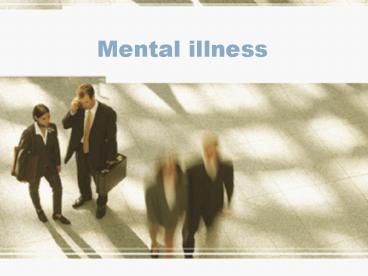Mental illness - PowerPoint PPT Presentation
1 / 18
Title:
Mental illness
Description:
Psychopathology: Scientific study of mental, emotional, and behavioral disorders. ... Statistical Abnormality: Having extreme scores on some dimension, such as ... – PowerPoint PPT presentation
Number of Views:57
Avg rating:3.0/5.0
Title: Mental illness
1
Mental illness
2
What is Normal?
- Psychopathology Scientific study of mental,
emotional, and behavioral disorders. - Subjective Discomfort Feelings of anxiety,
depression, or emotional distress. - Statistical Abnormality Having extreme scores on
some dimension, such as intelligence, anxiety, or
depression. - Social Nonconformity Disobeying societal
standards for normal conduct usually leads to
destructive or self-destructive behavior. - Situational Context Social situation, behavioral
setting, or general circumstance in which an
action takes place - Cultural Relativity Judgments are made relative
to the values of ones culture - The Medical Model Mental Illness is treated as a
physical disease.
3
Diagnosing Mental Illness
- Difficult for even professionals
- Case Study
4
General Risk Factors for Contracting Mental
Illness
- Social Conditions Poverty, homelessness,
overcrowding, stressful living conditions. - Family Factors Parents who are immature,
mentally ill, abusive, or criminal poor child
discipline severe marital or relationship
problems - Psychological Factors Low intelligence, stress,
learning disorders . - Biological Factors Genetic defects or inherited
vulnerabilities poor prenatal care, head
injuries, exposure to toxins, chronic physical
illness, or disability
5
Stereotypes of Psychological Disorders
- Psychological Disorders are a sign of personal
weakness. - Psychological disorders are incurable.
- People with psychological disorders are often
violent and dangerous. - People with psychological disorder behave in
bizarre ways and are very different from normal
people.
6
Psychodiagnosis The Classification of Disorders
- DSM-IV-TR (text revision)Diagnostic and
Statistical Manual of Mental Disorders, Fourth
Edition, Text Revision - criteria, descriptions and other information to
guide the classification and diagnosis of mental
disorders was published in 2000 replacing DSM-IV.
It is expected that DSM-V will replace DSM-IV-TR
sometime in the future. This revision of the
fourth edition of the manual published by the
American Psychiatric Association to set forth
diagnostic guidelines.
7
History of the DSM
- DSM-I 1952 (describe 60 disorders)
- DSM-II 1968
- DSM-III 1980 (Multiaxial system)
- DSM-III-R 1988
- DSM-IV 1993
- DSM- IV-TR 2000 (Over 200 disorders)
8
Multiaxial System
- Axis I Major clinical syndrome
- Axis II Personality and developmental disorders
- Axis III Physical Disorders and conditions
- Axis IV Severity of psychosocial stressors
- Axis V Global Assessment of Functioning (GAF)
Scale
9
A multiaxial evaluationPatient 58 year old male
- Axis I Major depression, alcohol dependence
- Axis II Dependent Personality disorder
- Axis III Alcoholic cirrhosis of liver
- Axis IV Severity 3 (moderate)
Anticipated retirement and change in residence,
with loss of contact with friends - Axis VGAF 44 Highest in in past year 55
- Back
10
Axis I Major Clinical Syndrome
- Disorders usually first evident in infancy ,
childhood or adolescence.(ADD, Bulimia and
anorexia) - Organic Mental disorder Temporary or permanent
dysfunction of brain tissue caused by diseases or
chemicals. - Psychoactive substance use disorders
- Schizophrenic Disorders (Grossly disorganized
behavior, delusions, and hallucinations) - Delusional disorder
- Mood Disorder
- Anxiety disorders
- Somatoform disorders
- Dissociative disorders
- Psychosexual disorder
- Back
11
Axis II Personality and Developmental Disorders
- Personality Disorders Disorders are patterns
of personality traits that are
longstanding, maladaptive, and inflexible and
involve impaired functioning or subjective
distress http//behavenet.com/capsules/disorders/
prsnltydsrdr.htm - Specific Developmental disorders Autism,
Mental retardation, reading, writing and
arithmetic disorders Back
12
Axis IIIPhysical disorders and conditions
- Physical disorders or conditions are recorded on
this axis. - Examples Diabetes, arthrities, and hemophilia
- Back
13
Axis IVSeverity of Psychosocial stressors (back)
14
Axis VGlobal Assessment of Functioning Scale
- 90-Absent or minimal symptoms, good functioning
in all areas - 60 Moderate symptoms or difficulty in social ,
occupational, or school functioning. - 30 Behavior considerably influenced by delusions
or hallucinations, serious impairment in
communication or judgment, or inability to
function in almost all areas - 10 Persistent danger of severely hurting self or
others - BACK
15
Mood Disorders
- Class of disorders marked by emotional
disturbances of varied kinds that may spill over
to disrupt physical, perceptual, social, and
thought processes. - Major Depression, bipolar disorder, dysthymic
disorder and cyclothymic
16
Sample Case Study for Major Depressive Episode
17
Anxiety Disorders
- Disorders characterized by physiological signs of
anxiety (for example, palpitations) and
subjective feelings of tension, apprehension, or
fear. Anxiety may be acute and focused (panic
disorder) or continual and diffuse (generalized
anxiety disorder)
18
Sample Case Study for Major Depressive Episode































